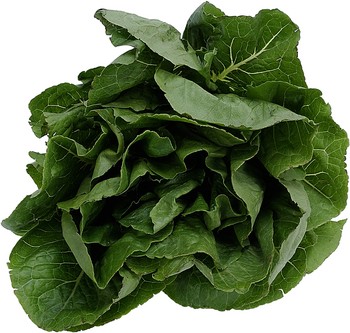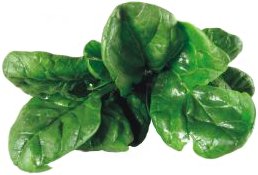

Spinach

Spinacia oleracea. Chenopodiaceae. An annual grown for its edible leaves. It is believed to have originated in Central Asia and has a long history of cultivation. It was grown in China as early as the 7th century and in Ethiopia by the 14th century. It is a cool-season crop, growing best where the average temperature is around 16-18ºC, but will withstand much lower temperatures, young plants withstanding frost down to –9ºC. Plants will produce flowers under long-day conditions, particularly at higher temperatures and in situations where plants are in close competition. Using appropriate cultivars and sowing dates it is possible in most areas to maintain a supply of freshly harvested leaves throughout the year. Tender young leaves can be served raw in salads but older leaves, and those of the rougher-leaved ‘Savoy-leaved’ spinach, are usually served as a cooked vegetable. Spinach will tolerate light shade and can therefore be grown as an intercrop between slower-growing species. It does best on a fertile soil rich in organic matter, well drained but moisture retentive. The pH should be neutral to slightly alkaline and acid soils should be limited. Nitrogen is essential for rapid growth and spinach benfits from a top dressing of a nitrogenous fertiliser during growth. There are two forms of spinach, one with round seeds, used for a summer crop, the other a hardier type with prickly seeds, more suited for an overwintered crop. Summer spinach should be sown as early as soil conditions permit at the beginning of the year and continued at three-weekly intervals into early summer. Seeds should be sown in 2cm deep drills about 30cm apart. Within-row spacing of 15cm between plants should be achieved by thinning. Plants should be kept free of weeds and well watered throughout growth. Harvesting commences within 10-12 weeks from sowing, continuing until late autumn providing plants do not bolt prematurely. The overwintered crop is sown in late summer allowing slightly more room within rows (around 22cm) and can be harvested throughout winter until spring. The use of cloches will improve the quality of the winter crop. Leaves can either be harvested individually as required or the entire shoot can be cut off at about 2-3cm above ground level, leaving the plant to produce new growth under favourable conditions. Recommended cultivars include: (summer) ‘America’, ‘Bloomsdale’, ‘Dominant’, ‘Indian Summer’, ‘Long Standing’, ‘Polka F1’, ‘Tyee F1’; (winter) ‘Broadleaved Prickly’, ‘Caballero’, ‘Greenmarket’, ‘Winter Bloomsdale’. Dual purpose cultivars are ‘Jovita’, ‘Norvack’, ‘Sigmaleaf’ and ‘Tyee’. 
Susceptible to downy mildew (Perenospora effusa) and leaf spot (Heterosporium variabile); the various leaf spot fungi and virus diseases, including blight, are best controlled by use of tolerant cultivars. Spinach may be attacked by birds. New Zealand SpinachTetragonia tetragonioides. Aizoaceae. A sprawling perennial cultivated for its edible young shoots and succulent leaves. It was discovered growing wild in New Zealand by Capt. James Cook in 1770, and is also indigenous to the coastal region of South and Western Australia and Tasmania. It is cultivated as a minor crop throughout most areas of the tropics and temperate regions. It is drought resistant and heat tolerant but cannot withstand frost. It is a useful substitute for spinach during hot dry conditions, when the latter is prone to bolt. Young shoots and leaves can be eaten raw in salads or cooked like spinach. The ‘seed’ consists of hard, dry, angular fruit 8-19mm long containing several true seeds. These are best soaked in water for 24 hours before sowing in order to accelerate germination which may otherwise be slow and erratic. For early summer use plants can be raised singly in pots under protection for planting out at a spacing of 60-90cm between plants once the risk of frost has passed. Tender shoots 15-20cm long are harvested as required through the summer until growth ceases in autumn. Usually free from disease but susceptible to aster yellows and several viruses. Spinach(From Latin spina; there are prickly processes on the fruit in some forms of the plant.) Chenopodiaceae. Three species of annual or biennial glabrous herbs. Leaves large, flat. Flowers small, unisexual; male flowers 4-5 lobed, in dense spicate inflorescence, female flowers axillary, perianth absent but surrounded by 2-4 bracteoles, enlarging, hardening and becoming connate in fruit; stigmas 4-5. SW Asia. Z5. Spinacia oleraceaStems to 1m or more, erect. Leaves bright green, ovate to triangular-hastate, entire or dentate, variable in size. Fruiting bracteoles orbicular-obovate, usually wider than long, often with divergent apical spine. Origin unclear, possibly SW Asia.
|
Home
Grow Nuts
Grow Herbs
Grow Fruit
Cyberian Index
If you like this website and want one of your own contact
Cyberian All information correct at
time of publication and open to updates as necessary. No part of this website,
or its vectors, may be produced in any shape or form, using any type or design
of medium, system, equipment or otherwise without the prior written consensual
notice of the Cyberian. Any breach of these requirements will result in the
appropriate action. If in doubt, e-mail contact is recommended.
Some components of this website were obtained as open-source software and are
used in the same non-profit manner on this website.